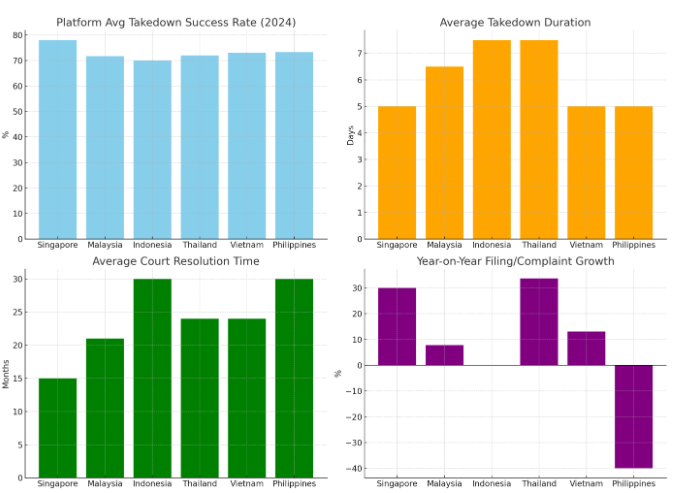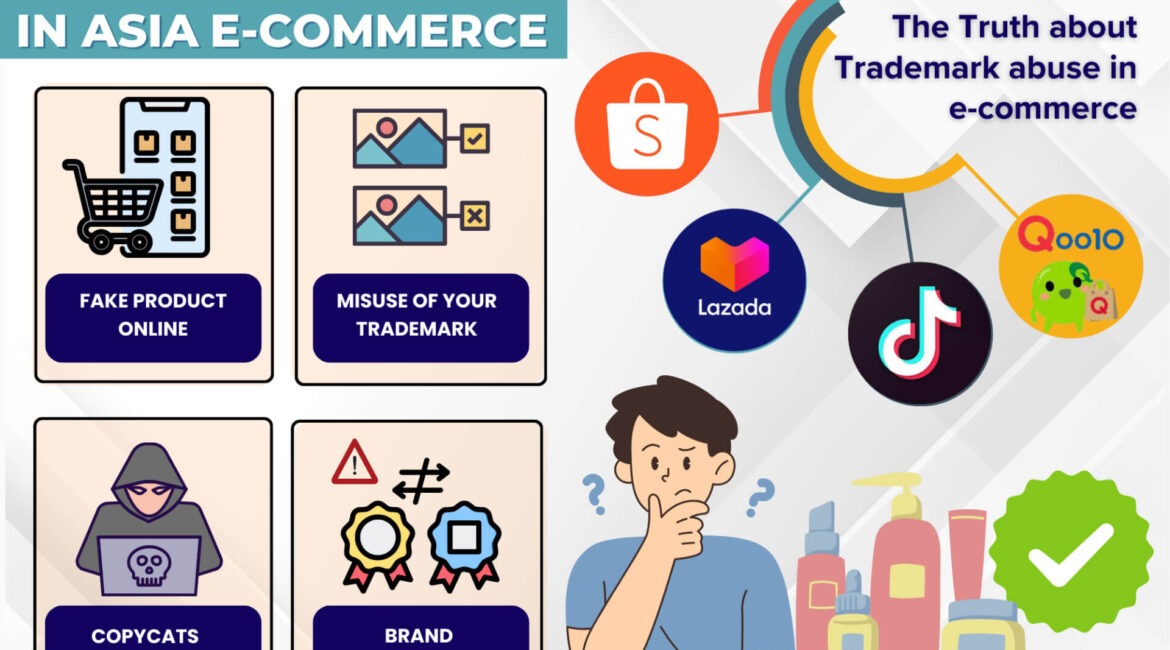Click, Cart, Infringe? How Your Trademark Can Be Misused Online? Is Your Brand Safe Online?
The Truth About Trademark Abuse in E-Commerce
Selling online is easy. Protecting your brand? Not so much.
You have built your brand from scratch—product, logo, identity. Then one day, copycats start using your name or logo online to sell lookalikes. Customers get confused, bad reviews roll in, and your reputation suffers—all through no fault of your own.
It is not just unfair. It is damaging.
As E-commerce platforms like TikTok Shop, Shopee, and Lazada grow, so does the risk of trademark abuse. Selling online gives small brands big opportunities—but it also opens the door to silent threats like infringement.
What is Trademark Infringement in E-commerce?
Trademark Infringement basically happens when someone uses a brand name, logo or design that is already registered by someone else, or something similar or even identical, without permission. For example, it is like setting up a shop that looks just like a famous store, hoping no one notices the difference. However, via online – it is even easier for copycats to do this and harder for buyers to tell the difference.
Common Types of Trademark Infringement in E-commerce
| Type of Infringement | What It Looks Like |
|---|---|
| Unauthorised Use of Brand Name/ Logo | A seller uses your brand name or logo (or something confusingly similar) without permission to mislead customers. |
| Passing Off | Copying your packaging, fonts, or colours to make their product look like yours. |
| Deceptive Listings | Inserting your brand name into their product titles or descriptions to show up in search results. |
| Misuse in Ads & Search Tags | Using your brand name in online ads or meta-tags to redirect traffic to their listings—damaging your visibility and sales. |
This overview is for general informational purposes only. Laws, platforms, and enforcement practices may change over time.
(Last updated: 12-8-2025)
ASEAN E-Commerce Trademark Enforcement Overview
Part 1: Infringement Types, Platforms, Laws & Authorities
| Country | Common Infringement Type | Main E-commerce platforms | Governing Legislation | Enforcement Authorities |
|---|---|---|---|---|
| Singapore |
| Shopee, Lazada, Qoo10, TikTok Shop | Trade Marks Act 1998 (Cap. 332) | IPOS, CASE, Singapore Customs, Police |
| Malaysia |
| Shopee, Lazada, TikTok Shop | Trademarks Act 2019 Trade Descriptions Act 2011 | MyIPO, KPDN, Royal Malaysian Customs, MCMC, Police |
| Indonesia |
| Tokopedia, Shopee, Lazada | Trademark Law No. 20/2016 | DGIP, Customs, PPNS (Civil Servant Investigators) |
| Thailand |
| Lazada, Shopee, JD Central, TikTok | Trademark Act B.E. 2534 (1991), amended 2016 | DIP Thailand, Customs, Economic Crime Suppression Division |
| Vietnam |
| Shopee, Tiki, Lazada | Law on Intellectual Property (amended 2022) | NOIP, Market Surveillance Agency, Customs |
| Philippines |
| Lazada, Shopee, TikTok, Zalora | IP Code of the Philippines (R.A. 8293) | IPOPHL, Bureau of Customs, NBI, PNP |
This overview is for general informational purposes only. Laws, platforms, and enforcement practices may change over time.
(Last updated: 12 August 2025)
Part 2: Success Rates, Litigation Times, Interception and Trends (2023-2025)
| Country | Platform Takedown Success Rate (2024) (Official /Estimation) | Average Takedown Duration | Average Court Resolution Time | Customs / Raids | Year-On Year Complaint/Filing Growth (Official / Estimation) |
|---|---|---|---|---|---|
| Singapore | Shopee: 82% Lazada: 78% Qoo10: 74% | 3-7 business days | 12-18 months | 65 trademark raids; 73 total IPR raids; S$3.74M seized (IPOS) | Trademark filings up ~30% over five years (IPOS) |
| Malaysia | Shopee: 75% Lazada: 72% TikTok: 68% | 3-10 business days | 18-24 months | 265+ cases, seizures rising (cosmetics, electronics) via MyIPO & KPDN enforcement reports | 7.8% growth in IP filings in 2024 (MyIPO) |
| Indonesia | Tokopedia: 71% Shopee: 69% | 5-10 business days | 24-36 months | DGIP destroyed Rp 5.35 B goods (cosmetics, food, medicines) in late 2024 (~USD 360K) | Enforcement spikes noted in 2023 per DGIP reports (not publicly quantified) |
| Thailand | Lazada: 74% Shopee: 70% | 5-10 business days | 18-30 months | 1.33M counterfeit items seized in H1 2024 (DIP, Customs) | Seizures grew ~33.7% YoY in H1 2024 (official) |
| Vietnam | Shopee: 77% Lazada: 73% Tiki: 69% | 3-7 business days | 20-28 months | 220 criminal IP investigations in 2022; 112 proceeded to trial with 241 defendants | 125,778 IP applications filed in 2023 (+13.1% over 2022) (NOIP) |
| Philippines | Shopee: 76% Lazada: 74% Zalora: 70% | 3-7 business days | 24-36 months | IPOPHL received 92 counterfeiting/piracy complaints Jan–Nov 2022 (majority apparel & beauty) | Complaints dropped from 153 in 2021 to 92 in first 11 months of 2022 (–40%) (IPOPHL) |
Figures are based on available public reports and industry estimates, and may not reflect complete or official statistics for all jurisdictions.
(Last updated: 12 August 2025)

Figures are compiled from public reports, platform disclosures, and industry estimates. Actual enforcement metrics may vary and may not reflect complete or official statistics.
(Last updated: 12 August 2025)
Part 3: Trademark Infringement Enforcement Workflow by Country
| Country | Initial Action | Cease & Desist / Warning | Administrative / Platform Escalation | Border Measure | Civil Litigation |
|---|---|---|---|---|---|
| Singapore | Submit IP complaint to platform | Send cease-letter to seller or platform | Escalate to IPOS if platform non-responsive; mediation offered | Customs seizure upon notice (Customs Act guidance) | File civil suit at High Court or IPOS for damages, injunction |
| Malaysia | Report via platform IP portal | Cease letter via legal representation or law firm | Option for MyIPO verification at Registrar; KPDN may initiate enforcement raids under TMA 2019 | Customs detention under Customs Act | Civil suit at High Court or Sessions Court for damages, injunction |
| Indonesia | File IP complaint on platform portal | Send warning letter (often via DGIP) | DGIP administrative intervention or investigation; PPNS involvement possible | Customs seizure under Directorate General of Customs | Civil action in Commercial Court for damages, injunction |
| Thailand | Use platform brand IP portal to report infringement | Cease letter (Thai language recommended) | Lodge complaint with DIP or DSI when platform takedown fails; may proceed to IP/IT Court | Customs seizure via Department of Customs | Civil lawsuits in Central Intellectual Property and International Trade Court |
| Vietnam | Report via NOIP or market surveillance portal | Cease notification or administrative warning | Administrative fines and seizure by Market Surveillance | Customs seizure by General Department of Customs | Civil litigation in specialized IP Court |
| Philippines | File platform complaint via Shopee, Lazada portals | Cease letter often coordinated by brand or IPOPHL | Administrative action by IPOPHL including investigation | Customs seizure under Customs Modernization Act | Civil case filed at Regional Trial Courts or Court of Appeals |
This overview is for general informational purposes only. Laws, platforms, and enforcement practices may change over time.
(Last Updated: 12 August 2025)
Proactive Strategies to Prevent IP Infringement on E-Commerce Platforms
Prevention is always better than cure.
Before launching your product or store online, especially across key ASEAN markets, it is wise and a must to register your trademark and other relevant IP rights in each key market. Some E-commerce platforms like Shopee and Lazada do offer brand protection tools, but you can only use them if your rights are properly registered. It is also a must to monitor online listings regularly, use watermarking or distinct packaging, and if needed, engage someone to help keep an eye on copycats.
A little effort upfront can save you a lot of trouble later.
Conclusion: Protecting Your Brand in the Digital Age
In today’s digital-first economy, E-commerce platforms across ASEAN- like those in Singapore, Thailand, and Malaysia, have transformed how businesses reach consumers, but they have also changed how IP is infringed. As seen in the cases discussed above, brand owners can no longer afford to wait until harm is done. The reality is, once your mark appears online, it’s vulnerable to misuse, imitation, and grey market resale.
To stay ahead, businesses must take an active role in protecting their IP, not just through registration, but through constant monitoring, clear internal policies, and strategic enforcement. In ASEAN’s fast-growing online market, safeguarding your brand isn’t just a legal step — it is a business strategy.
Dated :12 August 2025

